TAQS IM Solo v2.0.1 download free
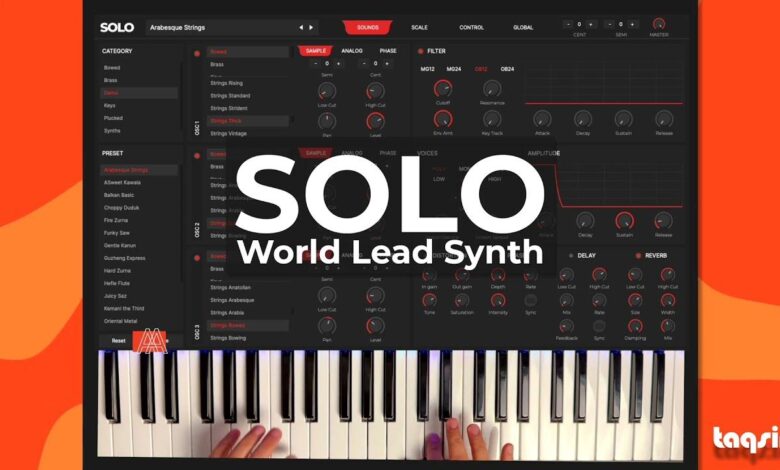
SOLO: The Ultimate World Lead Synth
Unleash your creative potential and embark on a sonic journey like no other with SOLO, the cutting-edge virtual instrument plugin designed to transport your music to new horizons.
Featuring a unique blend of hybrid synthesis, microtonal scales, and world music sounds, SOLO is the ultimate tool for composers, producers, and musicians seeking to infuse their compositions with captivating global flavors.
SOLO is designed to allow you to easily explore presets, fine-tune sounds, tweak playbility, implement intricate modulations, or venture into the realm of microtonal scales. Collaborating with musicians and producers worldwide, we have carefully curated a unique library of authentic sounds to help you stand apart from the crowd. Moreover, for those seeking even greater customization, SOLO allows you to import your own Korg KMP or SoundFont multi-samples, inviting you to explore new sonic frontiers and infuse your music with a unique personal touch. With SOLO, the possibilities are limitless, and your creative expression knows no bounds.
Getting Started
Download
You will receive a download link in your email when purchasing SOLO or requesting the Demo. You can also download the installer files here from our official WeTransfer links below:
Version 3.0.0
- SOLO Windows Installer version 3.0.0 Download (Win 10+)
- SOLO Mac Installer version 3.0.0 Download (MacOS 11+)
Version 2.0.1
- SOLO Windows Installer version 2.0.1 Download (Win 10+)
- SOLO Mac Installer version 2.0.1 Download (MacOS 11+)
Version 1.2.13
- SOLO Windows Installer version 1.2.13 Download (Win 10+)
- SOLO Mac Installer version 1.2.13 Download (MacOS 11+)
Installation
Mac Installation
A Mac AU / VST / AAX and Windows VST / AAX installation packages are available.
To install the SOLO MAC AU / VST / AAX installation package complete the following steps:
- Download the current SOLO MAC Installer from the links above
- Unzip the File on your local machine
- Run the “TAQSIM SOLO Mac.pkg” file
- Restart Your Computer
- Run SOLO from the Applications folder
- When SOLO opens for the first time, select either the 15-minute trial or to enter your purchased license key information that was emailed to you upon purchase
Windows Installation
To install the SOLO Windows VST / AAX installation package complete the following steps
- Download the current SOLO Windows Installer above
- Unzip the File on your local machine
- Run the “TAQSIM SOLO Windows.exe” file to install the software
- Restart Your Computer
- Open SOLO from Programs
- When SOLO opens for the first time, select either the 15-minute trial or to enter your purchased license key information that was emailed to you upon purchase
- Note, there is no DLL file. A .vst3 file is installed in C:\Program Files\Common Files\SOLO.vst3
In Use
Using the Standalone Version
The standalone version of SOLO allows you to play the virtual instrument without it being hosted in a DAW. To start playing the virtual instrument first make sure you have a MIDI controller plugged into your computer and have an Audio Interface that can support low-latency sound.
Click the Options button on the top, then select the Audio/MIDI Settings button. A dialog box will open up where you can select the output you would like to send audio from SOLO to along with its respective Sample Rate and Audio Buffer Size.
Select the MIDI controller you would like to use via the Active MIDI Input dialog box. If you have a Bluetooth MIDI controller, select the Bluetooth MIDI button and select the appropriate controller.
Close the dialog box once the Audio/MIDI settings are complete. You can play sounds by selecting a category within the Category area on the left-hand side and then a preset from the Preset area on the left-hand side.
Using the Plug-In Version
The VST / AU / AAX version of SOLO needs to be played through any DAW that supports the VST and/or AU format. Load the plugin within the DAW and ensure that it is receiving MIDI to play it. Once the plugin has been selected and can receive MIDI and output sound, you can play sounds by selecting a category within the Category area on the left-hand side and then a preset from the Preset area on the left-hand side.
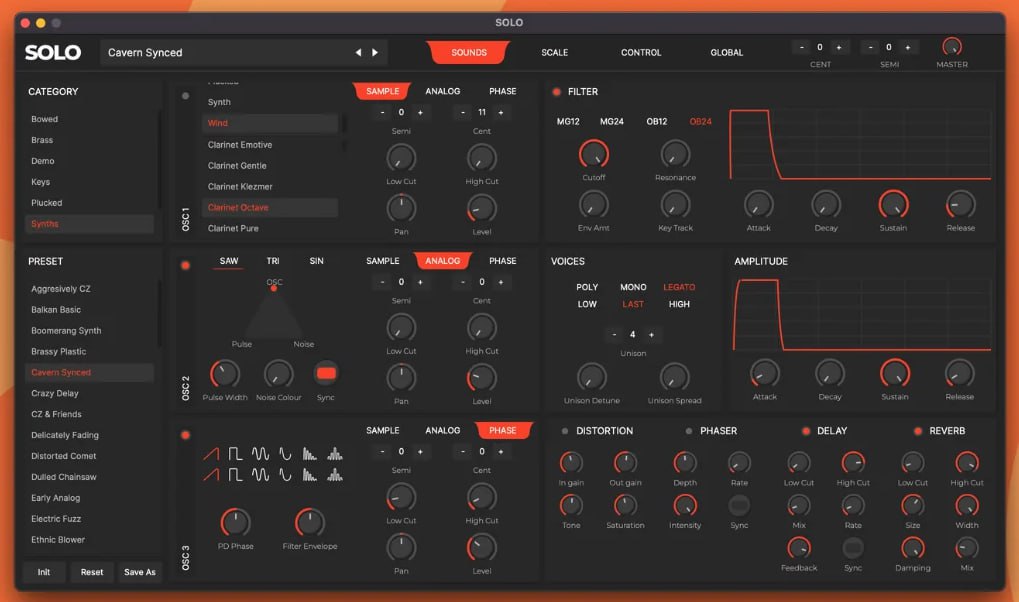
Oscillators
SOLO’s oscillator section allows you to mix and match 3 virtual analog-style oscillators or sample-playback waveforms. Each oscillator provides independent controls for you to tweak.
Sample Oscillator
Each Sample Oscillator (SAMPLE) section has the following controls:
- Sample Category: Select the category of the wave sample you would like to use
- Sample: Select the specific wave sample you would like to use for the oscillator
- Semi (Semitone): Adjust the semitones of the oscillator
- Cent (Cents): Adjust the cents of the oscillator
- Low Cut: Add a low cut eq to the oscillator
- High Cut: Add a hi cut eq to the oscillator
- Pan: Adjust the left-right panning of the oscillator
- Level: Adjust the level of the oscillator
Analog Oscillator
Each Virtual Analog Oscillator (ANALOG) section has the following controls
- Oscillator Type: Select from a SAW, TRI (Triangle), or SIN (Sine) oscillator
- Sync: Sync Osc 2 and Osc 3 (if they are set as OSC) to Osc 1
- Pulse Width (PW): Adjust the rate of the Pulse Width oscillator
- Pulse Magnitude (PM): Adjust the intensity of the PW Oscillator
- Noise: The level of the Noise Oscillator
- Semi (Semitone): Adjust the semitones of the oscillator
- Cent (Cents): Adjust the cents of the oscillator
- Low Cut: Add a low cut eq to the oscillator
- High Cut: Add a hi cut eq to the oscillator
- Pan: Adjust the left-right panning of the oscillator
- Level: Adjust the level of the oscillator
Phase Distortion Oscillator
Each Phase Distortion Oscillator (PHASE) section has the following controls
- Oscillator Row 1: Select from a Saw, Square, Double Sine, Pulse, Resonant Saw or Resonant Tri oscillators
- Oscillator Row 2: Select from a Saw, Square, Double Sine, Pulse, Resonant Saw or Resonant Tri oscillators
- PD Phase: Set the phase of the wave
- Filter Envelope: Set the amount the filter envelope is applied to the oscillator
- Semi (Semitone): Adjust the semitones of the oscillator
- Cent (Cents): Adjust the cents of the oscillator
- Low Cut: Add a low cut eq to the oscillator
- High Cut: Add a hi cut eq to the oscillator
- Pan: Adjust the left-right panning of the oscillator
- Level: Adjust the level of the oscillator
Filter
Choose between either a Moog-style ladder or an Oberheim-style filter to shape the sonics of your sound. The filter section has the following controls:
- Filter Type: Select between MG12 (Moog-style -12db ladder filter) / MG24 (Moog-style -24db ladder filter) / OB12 (Oberheim-style -12db SEM filter) / OB24 (Oberheim-style -24db SEM filter)
- Cutoff: Set the cutoff of the filter
- Resonance: Set the resonance of the filter
- Env Amount: Set the amount of the envelope applied to the filter
- Key Track: Set the key track of the filter
- Attack: Set the attack of the filter
- Decay: Set the decay of the filter
- Sustain: Set the sustain of the filter
- Release: Set the release of the filter
Voices
SOLO allows you to weak how the voicing of the preset. The voicing section has the following controls:
- Poly / Mono / Legato: Choose between a polyphonic, monophonic or legato mode
- Low / Last / High: Choose the priority of the note to be played when in Mono / Legato mode
- Unison: Select the number of voices that will be set to Unison for the oscillators
- Unison Detune: Adjust the amount the unison oscillators are detuned from each other
- Unison Spread: Adjust how much the unison oscillators are spread within the stereo spectrum
Amplitude
Shape the loudness of your sound with a traditional ADSR Filter. The loudness filter section has the following controls:
- Attack: Set the attack of the filter
- Decay: Set the decay of the filter
- Sustain: Set the sustain of the filter
- Release: Set the release of the filter
Effects
Use the onboard studio-quality EQ, Distortion, Phaser, Delay, and Reverb to shape your sound. The effect section has the following controls:
Distortion
The Distortion section has the following controls:
- In Gain: Set the Input Gain
- Out Gain: Set the Output gain
- Sat: Set the amount of Saturation
- Tone: Set the amount of Tone
Phaser
The Phaser section has the following controls:
- Depth: Set the depth of the phaser
- Rate: Set the rate of the phaser
- Intensity: Set the intensity of the phaser
- Sync: Sync the Phaser to the BPM in the DAW
Delay
The Delay section has the following controls:
- Low Cut: Apply a low cut filter
- High Cut: Apply a high cut filter
- Mix: Set the amount of mix
- Rate: Set the amount of time between delays
- Feedback: Set the amount of feedback
- Sync: Sync the Phaser to the BPM in the DAW
Reverb
The Reverb section has the following controls:
- Low Cut: Apply a low cut filter
- High Cut: Apply a high cut filter
- Size: Set the size of the Reverb
- Width: Set the width
- Damping: Set the amount of damping
- Mix: Set the amount of mix
Scales Page
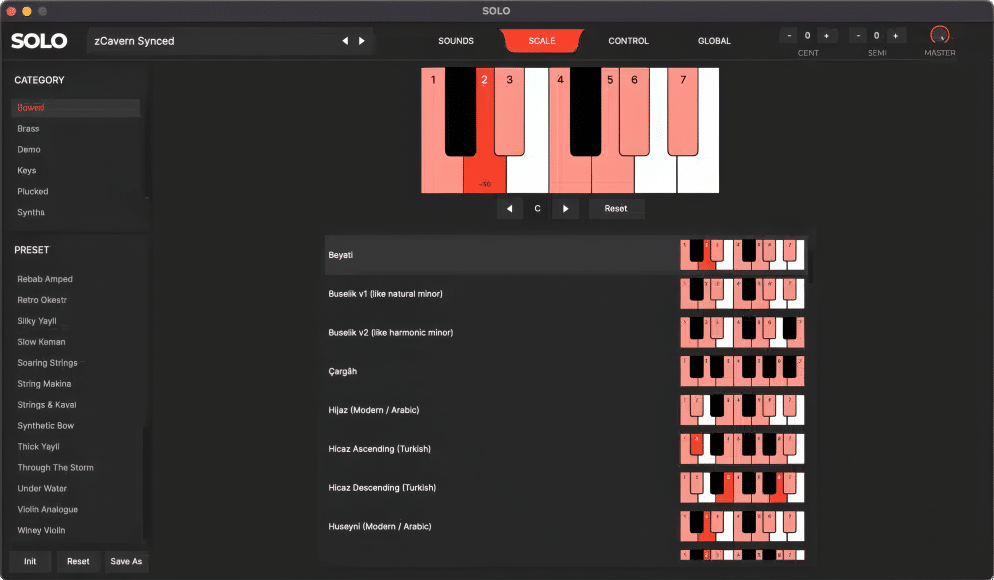
Break free of the twelve-tone scales by dialing in microtonal scales with an “oriental-style” scale converter. The scale converter section has the following controls:
- Scale: Enter in the amount of detuning by cents for each note
- Scale Select: Select one of the preset scales
- Root: Select the root of the scale, this transposes the preset scale to the selected root
- Reset: Reset the scale to its original setting
Control Page
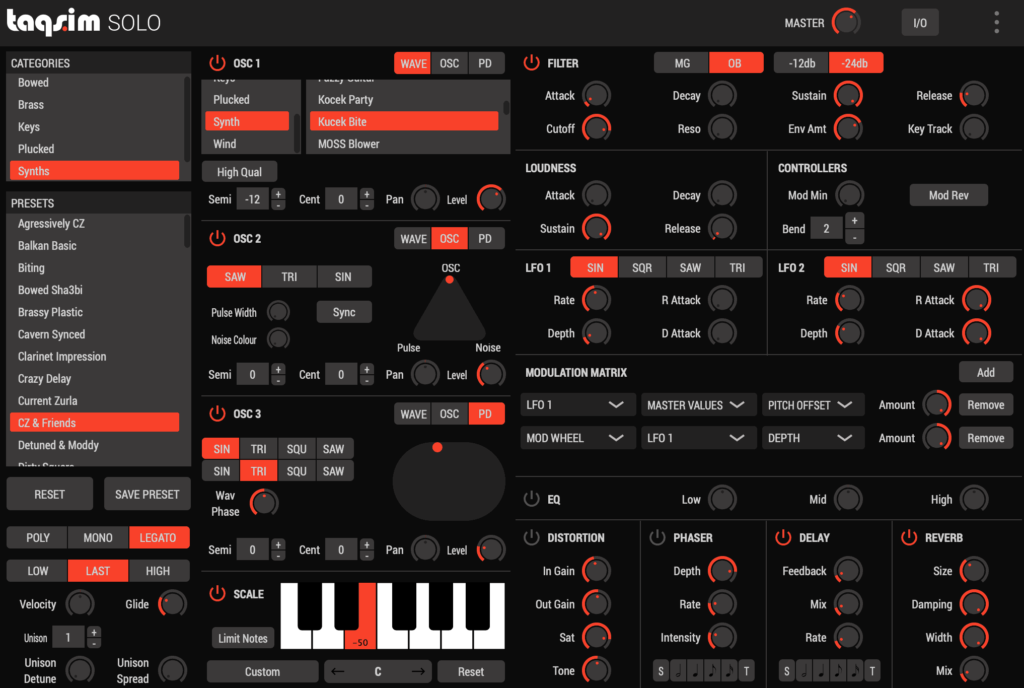
SOLO provides deep control on how the sound is played and modulated
LFO’s
Utilize 2 LFO’s (Low-Frequency Oscillator) within the Modulation Matrix. The LFO section has the following controls for each LFO:
- SIN / SQR / SAW / TRI: Set the type of LFO oscillator Sin (Sine), Sqr (Square), Saw, Tri (Triangle)
- Rate: Set the rate of the LFO
- R Attack: Set the attack of the LFO Rate
- Depth: Set the depth of the LFO
- D Attack: Set the attack of the LFO Depth
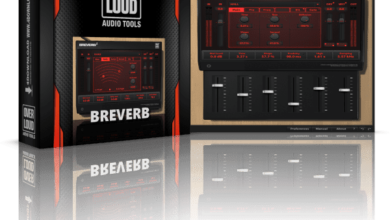

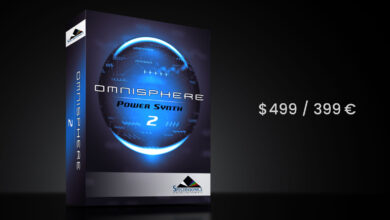
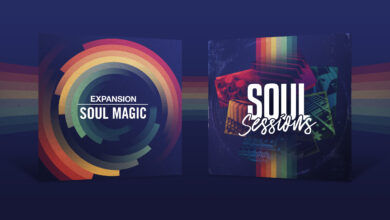

One Comment